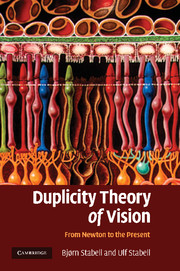Book contents
- Frontmatter
- Contents
- Acknowledgements
- 1 Introduction
- Part I The development of the basic ideas of the duplicity theory from Newton to G. E. Müller
- Part II The development of the duplicity theory from 1930–1966
- Part III Chromatic rod vision: a historical account
- Part IV Theories of sensitivity regulation of the rod and cone systems: a historical account
- 15 Introduction
- 16 Early photochemical explanations
- 17 Contribution of S. Hecht
- 18 Contribution of G. Wald: photochemical sensitivity regulation mechanisms of rods and cones
- 19 Relationship between amount of rhodopsin and sensitivity during dark adaptation
- 20 Post-receptor sensitivity regulation mechanisms
- 21 Rushton's AGC model
- 22 Contribution of H.B. Barlow
- 23 Rushton and Barlow compared
- 24 The Dowling-Rushton equation refuted
- 25 Several mechanisms involved in sensitivity regulation
- 26 Sensitivity regulation due to rod-cone interaction
- 27 Modern conceptions of sensitivity regulation
- Part V Factors that triggered the paradigm shifts in the development of the duplicity theory
- References
- Index
21 - Rushton's AGC model
Published online by Cambridge University Press: 22 January 2010
- Frontmatter
- Contents
- Acknowledgements
- 1 Introduction
- Part I The development of the basic ideas of the duplicity theory from Newton to G. E. Müller
- Part II The development of the duplicity theory from 1930–1966
- Part III Chromatic rod vision: a historical account
- Part IV Theories of sensitivity regulation of the rod and cone systems: a historical account
- 15 Introduction
- 16 Early photochemical explanations
- 17 Contribution of S. Hecht
- 18 Contribution of G. Wald: photochemical sensitivity regulation mechanisms of rods and cones
- 19 Relationship between amount of rhodopsin and sensitivity during dark adaptation
- 20 Post-receptor sensitivity regulation mechanisms
- 21 Rushton's AGC model
- 22 Contribution of H.B. Barlow
- 23 Rushton and Barlow compared
- 24 The Dowling-Rushton equation refuted
- 25 Several mechanisms involved in sensitivity regulation
- 26 Sensitivity regulation due to rod-cone interaction
- 27 Modern conceptions of sensitivity regulation
- Part V Factors that triggered the paradigm shifts in the development of the duplicity theory
- References
- Index
Summary
EACH RECEPTOR TYPE HAS A SEPARATE AND INDEPENDENT ADAPTATION POOL
Presupposing that the site of adaptation is located in summation pools situated centrally to the receptor level, one might expect that different kinds of receptor (rods, ‘red’, ‘green’ and ‘blue’ cones) would tend to interact in determining the adaptation process. In opposition to this view, however, Rushton (1965a) presented evidence suggesting that each class of receptor had a separate and independent AGC pool. Thus, he suggested that for rods and for each kind of cone the dependence of threshold on background and on bleaching were private, i.e. separate and independent.
Strong evidence in favour of independence between rod and cone adaptation pools was given by the well-known fact that the threshold level obtained during long-term dark adaptation may remain unchanged for several minutes during the cone-plateau period, while the sensitivity of the rods may increase by several log units. Indeed, with deep-red test light, the absolute threshold level of the cones may remain invariant for more than 20 min during the cone-plateau period before the rods eventually influence the threshold level. Furthermore, well-founded evidence in favour of the independence of the adaptation pools for all the different receptor types was found by Rushton (1965a) in the extensive research work of Stiles on incremental threshold (see Stiles, 1978). This research work may be illustrated by Stiles's well-known experiment together with Aguilar in 1954 on light adaptation of the rod mechanism.
- Type
- Chapter
- Information
- Duplicity Theory of VisionFrom Newton to the Present, pp. 160 - 168Publisher: Cambridge University PressPrint publication year: 2009



